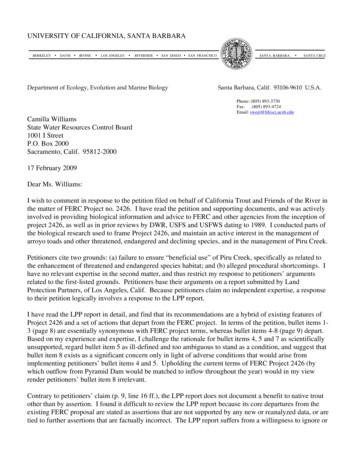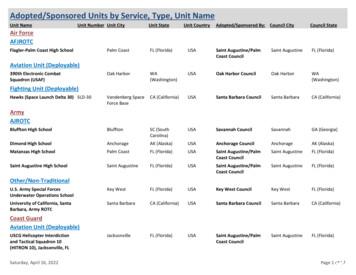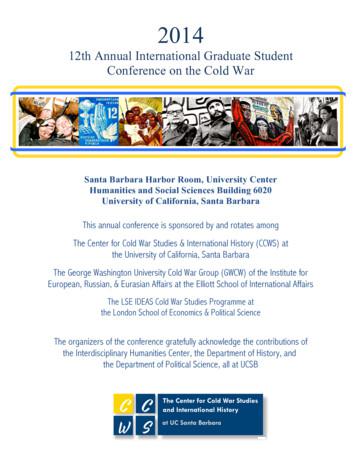University Of California Santa Barbara Final Report - UCOP
University of CaliforniaSanta BarbaraCampus Climate ProjectFinal ReportMarch 2014
Rankin & Associates ConsultingUC Campus Climate Assessment ProjectUC Santa Barbara Final Report – March 2014Table of ContentsExecutive Summary . iIntroduction . iProject Structure and Process. iDescription of the Sample at UC Santa Barbara . iiKey Findings - Areas of Strength . ivKey Findings - Opportunities for Improvement . vIntroduction . 1History of the Project . 1Campus Climate’s Influence on Academic and Professional Success . 5UC Campus Climate Assessment Project Structure and Process . 8University of California Santa Barbara (UC Santa Barbara) Project Specifics . 9Methodology . 10Conceptual Framework . 10Research Design. 10Results . 14Description of the Sample. 14Sample Characteristics . 19Campus Climate Assessment Findings . 46Comfort with the Climate at UC Santa Barbara . 46Perceptions of Level of Respect . 65Perceptions of Campus Accessibility. 67Personal Experiences of Exclusionary, Intimidating, Offensive or Hostile Conduct . 69Experiences of Unwanted Sexual Contact . 94Faculty and Staff Perceptions of Campus Climate . 96Campus Climate and Work-Life Issues . 105Perceptions of Employment Practices Within . 114Faculty Members’ Views on University Policies . 117Faculty/Staff/Post-Docs/Trainees Who Have Seriously Considered Leaving UC SantaBarbara . 122Students’ Perceptions of Campus Climate. 124Student Experiences of Unwanted Sexual Contact . 124Students’ Academic Experiences . 126Students’ Perceptions of Campus Climate. 132Students Who Have Seriously Considered Leaving UC Santa Barbara . 140Institutional Actions . 143Next Steps . 150
Rankin & Associates ConsultingUC Campus Climate Assessment ProjectUC Santa Barbara Final Report – March 2014References . 151Appendices . 154Appendix A – Crosstabulations by Selected Demographics. 155Appendix B – Data Tables 157Appendix C – Survey Instrument .257
Rankin & Associates ConsultingUC Campus Climate Assessment ProjectUC Santa Barbara Final Report – March 2014Executive SummaryIntroductionThe University of California (UC) is dedicated to fostering a caring universitycommunity that provides leadership for constructive participation in a diverse,multicultural world. The University has a long history of supporting initiatives that fosteran inclusive living, learning, and working environment. 1 A common recommendationoffered by these initiatives was the need for a comprehensive tool that would providecampus climate metrics for students, faculty, staff, and post-doctoral scholars across thesystem.To that end, the University contracted with Rankin & Associates, Consulting (R&A) toconduct a system-wide “Campus Climate” survey. The purpose of the survey was togather a wide variety of data related to institutional climate, inclusion, and work-lifeissues so that the University is better informed about the living and workingenvironments for students, faculty, staff, post-doctoral scholars at the ten UC campusesas well as the Office of the President, the Lawrence Berkeley National Laboratory, andthe Division of Agriculture and Natural Resources. Based on the findings, each UCcampus and the three locations will develop action plans and strategic initiatives toimprove the overall campus climate.Project Structure and ProcessThe development of the survey instrument was a collaborative effort between R&A and aSystem-wide Work Team (SWT). The SWT was comprised of at least tworepresentatives from each UC campus/location as well as representatives from studentassociations, employee unions, and the faculty. The UC Santa Barbara survey contained118 questions including several open-ended questions for respondents to providecommentary. The survey was offered in English and Spanish and distributed fromJanuary 3, 2013 through February 7, 2013 through a secure on-line portal. 2 Confidential1For example: Declaration of Community, 1993; Study Group on Diversity, 2006; Advisory Council onCampus Climate, Culture, and Inclusion, 2010.2All translations were provided by Kern translation services http://www.e-kern.com/us.html.i
Rankin & Associates ConsultingUC Campus Climate Assessment ProjectUC Santa Barbara Final Report – March 2014paper surveys were available to those who did not have access to an Internet-connectedcomputer or preferred a paper survey.The survey data were analyzed to compare the responses of various groups. Descriptivestatistics were calculated by salient group memberships (e.g., position status, genderidentity, racial identity) to provide additional information regarding participant responses.Meaningful and notable findings were included in the report based on chi-squareanalyses, information gleaned from the literature, and/or experiences of the consultant.Additional narrative was requested for several questions in the survey. For the purposesof this report, content analyses were conducted on questions where there was limitedquantitative data.Description of the Sample at UC Santa BarbaraUC Santa Barbara community members completed 8,193 surveys for an overall responserate of 30%. Response rates by constituent group varied: 23% for UndergraduateStudents (n 4,287), 39% for Graduate/Professional Students (n 1,141), 69% for PostDocs (n 149), 62% for Non-Union Staff (n 1,256), 41% for Union Staff (n 566),and 46% for Faculty (n 624).Table 1 provides a summary of selected demographic characteristics of surveyrespondents. The percentages offered in Table 1 are based on the numbers of respondentsin the sample (n) for the specific demographic characteristic. 3 Only surveys that were atleast 50% completed were included in the final data set for analyses.3The total n for each demographic characteristic will differ due to missing data. Definitions for eachdemographic characteristic used for analysis purposes are provided at the conclusion of the ExecutiveSummary.ii
Rankin & Associates ConsultingUC Campus Climate Assessment ProjectUC Santa Barbara Final Report – March 2014Table 1. UC Santa Barbara Sample DemographicsCharacteristicPosition statusnUndergraduate Students i4,28752.3Graduate/Professional Students .05537.0931.13314.07,75378.94094.2160.2No DisabilityDisability (physical, learning, mentalhealth/Psychological condition)6,15263.01,54215.7Christian Affiliation xiii2,50325.53763.8FacultyStaffiiiivPost-Doctoral ScholarsGender IdentityWomenMenTransgender viGenderqueer viiRacial IdentityWhitevUnderrepresented MinorityOther People of ColorviiiixMulti-Minority xSexual IdentityHeterosexualLesbian, Gay, Bisexual, QueerQuestioningAsexualCitizenship StatusxixiiU.S. CitizenNon-U.S. CitizenUndocumentedDisability StatusReligious/SpiritualAffiliation% ofSampleSubgroupOther Religious/Spiritual AffiliationMuslimxvJewish xviNo AffiliationxviiMultiple 5.83443.5Note: The total n for each selected demographic characteristic differs due to missing data.iii
Rankin & Associates ConsultingUC Campus Climate Assessment ProjectUC Santa Barbara Final Report – March 2014Key Findings - Areas of Strength1. High levels of comfort with the climate at UC Santa Barbara 84% of the survey respondents were “comfortable”/“very comfortable”with the climate at UC Santa Barbara (n 6,876), and 81% of respondentswere “comfortable”/“very comfortable” with the climate for diversity intheir department/work unit/academic unit/college/school/clinical setting (n 6,628). With regard to classroom climate, 77% of Undergraduate Students (n 3,302), 82% of Graduate/Professional Students (n 938), and 90% (n 577) of Faculty and Post-Docs were “comfortable” or “very comfortable”with the climate in their classes. White respondents, men, heterosexual respondents, and respondentswithout disabilities were more likely than their underrepresented peers tofeel “very comfortable” with the overall climate, the climate in theirdepartment/work unit/academic unit/college/school/clinical setting, and intheir classes.2. Faculty and Staff - Positive attitudes about work-life issues Three-quarters of Faculty, Staff, Post-Doc/Trainee, andGraduate/Professional Student respondents thought UC Santa Barbarademonstrated that it values a diverse faculty (76%, n 2,938) and staff(80%, n 2,764). More than half of all Faculty, Staff, Post-Docs/Trainees, andGraduate/Professional Students believed that they had colleagues or coworkers (78%, n 3,024) and supervisors (70%, n 2,720) at UC SantaBarbara who gave them career advice or guidance when they need it. The majority of Faculty, Staff, Post-Docs/Trainees, andGraduate/Professional Student respondents found UC Santa Barbarasupportive of taking leave (64%, n 2,461) and supportive of flexiblework schedules (73%, n 2,827).iv
Rankin & Associates ConsultingUC Campus Climate Assessment ProjectUC Santa Barbara Final Report – March 20143. Students - Positive attitudes about academic experiences 72% of Undergraduate Students (n 3,088) and 79% ofGraduate/Professional Students (n 894) were satisfied with theiracademic experience at UC Santa Barbara. 93% of all Undergraduate Students (n 3,938) and 96% ofGraduate/Professional Students (n 1,079) intended to graduate from UCSanta Barbara. 84% of all Undergraduate Students (n 3,582) and 69% ofGraduate/Professional Students (n 787) felt many of their courses thisyear have been intellectually stimulating.Key Findings - Opportunities for Improvement1. Some members of the community experienced exclusionary conduct 23% of respondents believed that they had personally experiencedexclusionary, intimidating, offensive and/or hostile conduct (n 1,890);7% of respondents indicated that the conduct interfered with their abilityto work or learn on campus 4 (n 555). Differences emerged based on various demographic characteristicsincluding position status, ethnic identity, and racial identity. For example,o A higher percentage of Staff respondents reported experiencingthis conduct as compared to Faculty or Students.o A higher percentage of racial, gender, and sexual minoritiesreported experiencing this conduct as compared to non-minorities.o A higher percentage of Undocumented Residents than Non-U.S.Citizens, and U.S. Citizens experienced this conduct.4The literature on microaggressions is clear that this type of conduct has a negative influence on peoplewho experience the conduct even if they feel at the time that it had no impact (Sue, 2010; Yosso, Smith,Ceja, & Solorzano, 2009).v
Rankin & Associates ConsultingUC Campus Climate Assessment ProjectUC Santa Barbara Final Report – March 20142. Several constituent groups indicated that they were less comfortable with theoverall campus climate, workplace climate, and classroom climate Staff respondents were less comfortable when compared with Faculty andPost-Doctoral Scholar respondents with the overall campus climate at UCSanta Barbara and the with the climate in their departments/work units. Respondents with disabilities were less comfortable with the overallclimate, with the workplace climate, and with the climate in their classesthan were respondents without disabilities. Multi-Minority respondents and Other People of Color respondents wereless comfortable than Underrepresented Minority respondents and Whiterespondents and with the overall climate, the workplace climate, and theclassroom climate. White respondents were more comfortable with theclimate in their classes than other racial groups.3. A small but meaningful percentage of respondents experienced unwantedsexual contact 8% of respondents believed they had experienced unwanted sexual contactwhile at UC Santa Barbara within the last five years (n 632). Subsequentanalyses of the data revealed the following: Of those respondents, 569 were Undergraduate Students (13% of allUndergraduate Students) and 21 were Graduate/Professional Students(2% of all Graduate/Professional Students). By gender identity: 18% of Women Undergraduates (n 493), 5% ofMen Undergraduates (n 69), and 33% of Genderqueer Undergraduates(n 13) experienced unwanted sexual contact.Additional findings disaggregated by position and other selected demographiccharacteristics are provided in more detail in the full report.The findings are consistent with those found in higher education institutions across thecountry based on the work of the consultant (Rankin & Associates, 2013). For example,70% to 80% of all respondents in similar reports found the campus climate to bevi
Rankin & Associates ConsultingUC Campus Climate Assessment ProjectUC Santa Barbara Final Report – March 2014“comfortable” or “very comfortable.” A slightly higher percentage of all surveyrespondents reported that they were “comfortable” or “very comfortable” with theclimate at UC Santa Barbara (84%). Additionally, 20% to 25% in similar reports believedthat they had personally experienced exclusionary, intimidating, offensive and/or hostileconduct. At UC Santa Barbara, 23% of respondents believed that they had personallyexperienced exclusionary, intimidating, offensive and/or hostile conduct. The results alsoparallel the findings of other climate studies of specific constituent groups offered in theliterature (Guiffrida, Gouveia, Wall, & Seward, 2008; Harper & Quaye, 2004; Harper, &Hurtado, 2007; Hurtado & Ponjuan, 2005; Rankin & Reason, 2005; Sears, 2002; Settles,Cortina, Malley, & Stewart, 2006; Silverschanz, Cortina, Konik, & Magley, 2008; Yosso,Smith, Ceja, & Solórzano, 2009).iUndergraduate Student refers to students who were taking classes at a UC campus when the surveywas administered who had not yet completed a bachelor’s degree.iiGraduate/Professional Student refers to students who were taking classes at a UC campus when thesurvey was administered who had completed a bachelor’s degree and were in one of the following statuses:non-degree, certificate/teacher credential program candidate, Master’s degree student, Doctoral degreestudent (Ph.D., Ed.D.), and Professional degree student (e.g., MD, JD, MBA)iiiFaculty refers to a UC employee in one of the following statuses: Faculty Administrator (e.g. ViceProvost, Dean, Department Chair, Director), General Campus Faculty, and Health Sciences CampusFacultyivStaff refers to a UC employee in one of the following statuses: Non-Union, Union, and OtherAcademic Series (e.g., Librarian, Continuing Educator, Reader, Research titles)vPostdoctoral scholars refers to individuals holding a doctoral degree who are engaged in a temporaryperiod of mentored research and/or scholarly training for the purpose of acquiring the professional skillsneeded to pursue a career path of his or her choosing. This includes both Employees and Paid-Directs.Trainees refer to Health Science campus Residents/Fellows/Housestaff/Interns - including Post MD andPost-MD II-IV and Chief Post MD-Officer.viTransgender was defined for this project as an umbrella term referring to those whose gender identity(a person’s inner sense of being man, woman, both, or neither. One’s internal identity may or may not beexpressed outwardly, and may or may not correspond to one’s physical characteristics) or genderexpression (the manner in which a person outwardly represents gender, regardless of the physicalcharacteristics that might typically define the individual as male or female) is different from thattraditionally associated with their sex assigned at birth (refers to the assigning (naming) of the biologicalsex of a baby at birth). Self-identification as transgender does not preclude identification as male or female,nor do all those who might fit the definition self-identify as transgender. Here, those who chose to selfidentify as transgender have been reported separately in order to reveal the presence of a relatively newcampus identity that might otherwise have been overlooked.viiGenderqueer refers to a person whose gender identity is neither man nor woman, is between orbeyond genders, or is some combination of genders. This identity is usually related to or in reaction to thesocial construction of gender, gender stereotypes and the gender binary system. Some genderqueer peopleidentify under the transgender umbrella while others do not. Self-identification as genderqueer does notpreclude identification as male or female, nor do all those who might fit the definition self-identify astransgender. Here, those who chose to self-identify as genderqueer have been reported separately in orderto reveal the presence of a relatively new campus identity that might otherwise have been overlooked.vii
Rankin & Associates ConsultingUC Campus Climate Assessment ProjectUC Santa Barbara Final Report – March 2014viiiThe Underrepresented Minority variable includes African American/African/Black respondents,American Indian/Alaskan Native respondents, and Hispanic/Latino respondents AND individuals whochecked both the Underrepresented Minority and White responses.ixThe Other People of Color variable includes Asian/Asian American respondents, MiddleEastern/Southwest Asian/North African respondents, and Pacific Islanders AND individuals who checkedboth the Other People of Color and White responses.xThe Multi-Minority variable includes respondents who checked any of the responses included underthe aforementioned “Underrepresented Minority” and “Other People of Color” categories ANDrespondents who checked “Underrepresented Minority,” “Other People of Color,” and White.xiQuestioning refers to a person who questions his or her sexual identity or gender identity and does notnecessarily identify as definitively gay, for example.xiiAsexual refers to a person who does not experience sexual attraction. Unlike celibacy, which peoplechoose, asexuality is an intrinsic part of an individual.xiiiThe Christian Affiliation variable includes respondents who chose any Christian religious/spiritualaffiliation.xivThe Other Religious/Spiritual Affiliation variable includes respondents who chose Buddhist,Confucianist, Druid, Hindu, Jain, Native American Traditional Practitioner, Pagan, Rastafarian,Scientologist, Secular Humanist, Shinto, Sikh, Taoist, Unitarian Universalist, and Wiccan.xvThe Muslim variable includes respondents who chose Ahmadi Muslim, Muslim, Shi’ite, Sufi, andSunni.xviThe Jewish variable includes respondents who chose Jewish Conservative, Jewish Orthodox, andJewish Reform.xviiThe No Affiliation variable includes respondents who chose agnostic; atheist; no affiliation; andspiritual, but no affiliation.xviiiThe Multiple Affiliations variable includes respondents who chose more than onespirituality/religious affiliation.viii
Rankin & Associates ConsultingUC Campus Climate Assessment ProjectUC Santa Barbara Final Report – March 2014IntroductionHistory of the ProjectThe University of California is dedicated to fostering a caring university community thatprovides leadership for constructive participation in a diverse, multicultural world. TheUniversity has a long history of supporting initiatives that foster an inclusive living,learning, and working environment. For example, in 1993 a University-wide campuscommunity task force offered A Declaration of Community that adopted seven principlesto assess the state of community at the University. “These principles, derived from thecore values which define and sustain the University, delineate both the individual's rightsand responsibilities that flow from being a member of the campus community, as well asdefine the community's obligations to its members” (Handel & Caloss, p.2). In 2006, aUniversity’s Board of Regents’ Study Group on University Diversity was established toexamine the current state of diversity and identify actions for improving diversity at theUniversity. The Study Group identified three key principles and policy recommendations.Acting on the initial set of recommendations, the Board of Regents affirmed the centralityof diversity to the University’s mission and the need for improvements in this area andadopted as University policy a Diversity Statement (Regents Policy 4400), which reads inpart: “Because the core mission of the University of California is to serve the interests ofthe State of California, it must seek to achieve diversity among its student bodies andamong its employees” (Parsky & Hume, 2007, p. E-1).One of five reports produced by the Study Group, the Campus Climate Report, offeredthat while a “number of studies have been conducted that address climate for a specificconstituent group (e.g., UCUES, 5 NSSE, 6 SERU, 7 HERI8), or at a specificcampus/location (e.g., UC Faculty Survey, UC Riverside Campus Climate Study), nodata currently exist that supports a conclusive understanding of the climate at any of ourcampuses and the system as a whole” (Study Group on University Diversity-CampusClimate Report, p. 5). The authors stated that the University “has not conducted or5678UCUES - University of California Undergraduate Experience SurveyNSSE – National Survey of Student EngagementSERU – Student Experience in the Research UniversityHERI – Higher Education Research Institute – Faculty Survey1
Rankin & Associates ConsultingUC Campus Climate Assessment ProjectUC Santa Barbara Final Report – March 2014reported any comprehensive assessments of campus climate without data andcomprehensive, sustained assessment, the source and significance of individualperceptions and anecdotes regarding climate cannot be quantified or understood” (StudyGroup on University Diversity, p. 12).In 2008, the Staff Diversity Council and the UC Regents Study Group on CampusClimate both recommended regular climate assessments. They reiterated the findingsfrom the 2007 report suggesting that the only system-wide data available is embedded inthe UC Undergraduate Experience Survey (UCUES), an instrument which is not designedto measure campus/location climate. Despite the fact that UCUES was not intended tospecifically survey campus/location climate, a small portion of the questions can beuseful in beginning to understand undergraduate students’ perceptions of climate. Forexample, UCUES can demonstrate certain behaviors and attitudes regarding interactionswith peers and faculty, perspectives on the level of tolerance on campus or at a specificlocation, and the impact of the UC experience on students’ appreciation for diversity,understanding of racial and ethnic differences, and awareness of their own ethnic identity.However, it was recommended that additional and more specific assessment means wereneeded to draw solid conclusions regarding campus/location climate for all members ofthe University community.In February 2010, UC experienced a wave of incidents that generated significantattention to the need of the University to actively and collaboratively addresscampus/location climate challenges and complex intergroup dynamics. In early February2010, members of a UC San Diego fraternity held an off-campus party mocking BlackHistory Month. Later that same month at UCSD, a noose was discovered hanging from alamp on a bookshelf in the Geisel Library at the University. The incidents sparkedstudent and community demonstrations and calls for changes in the campus climate. Inlate February 2010, the Lesbian, Gay, Bisexual, Transgender (LGBT) Resource Center atUC Davis experienced acts of vandalism – the entrance to the Center was defaced withderogatory and hateful words that target the LGBT community. In response, thenPresident Mark G. Yudof formed a UC Advisory Council to the President on Campus2
Rankin & Associates ConsultingUC Campus Climate Assessment ProjectUC Santa Barbara Final Report – March 2014Climate, Culture, and Inclusion which included the appointment of several prominentCalifornians long associated with the struggle for equal rights and representatives fromUC’s faculty, administration, student body, alumni, and the local community. TheAdvisory Council was charged to identify, evaluate, and share best practices in order toensure a welcoming, inclusive and nurturing environment across UC’s campuses. TheAdvisory Council was asked to look broadly at other institutions, both public and private,in higher education and elsewhere, and to examine policies across the state and thenation. The President also directed each of UC’s Chancellors to create similar advisorycouncils at the campus level, which would set metrics, monitor progress, and reportregularly to the system-wide Advisory Council. While most campuses/locations alreadyhad existing bodies that do this work on an ongoing basis, then-President Yudof askedthem to redouble their efforts and, in some instances, adjust their mission or compositionto be more broadly inclusive.The Advisory Council revitalized discussions on the need for a comprehensive andregularized tool that can provide campus/location climate metrics for students, faculty,and staff across the system. The Advisory Council reviewed analysis that had beenconducted by a UC Office of the President committee on nearly 50 assessment tools andfindings that had been conducted across the UC system which include somecampus/location climate or diversity indicators, in addition to reviewing efforts by otherUniversities to conduct comprehensive climate studies. The review resulted in theidentification of seven best practices in University campus/location climate studies:1.2.3.4.5.6.7.Conduct a full study, not just a survey.Study should be comprehensive, including all constituent groups.Administer follow-up regularly.Administered by an external agency.Solicit significant input from internal constituencies.Develop communications plan.Develop action plan.Particularly important in the review of best practices was the need for external expertisein survey administration. In the committee’s assessment, administration of a surveyrelating to a very sensitive subject like campus/location climate is likely to yield higher3
Rankin & Associates ConsultingUC Campus Climate Assessment ProjectUC Santa Barbara Final Report – March 2014response rates and provide more credible findings if led by an independent, outsideagency. Staff may feel particularly inhibited to respond honestly to a survey administeredby their own institution for fear of retaliation.Following a national vetting, Rankin & Associates (R&A) was identified as a leader inconducting multiple studies examining multiple identities in higher education. Followingpresentations to the President and his Cabinet, the Chancellors, and the Advisory Councilon Campus Climate, Culture, and Inclusion, the UC Office of the President contractedwith R&A to facilitate a system-wide climate assessment.The system-wide assessment was further evidence of the University’s commitment toensuring that all members of the community live in an envir
Description of the Sample at UC Santa Barbara UC Santa Barbara community members completed 8,193 surveys for an overall response rate of 30%. Response rates by constituent group varied: 23% for Undergraduate Students (n 4,287), 39% for Graduate/Professional Students (n 1,141), 69% for Post-Docs (n 149), 62% for Non-Union Staff (n
B.J.M. de Rooij B.J.W. Thomassen eo B.J.W. Thomassen eo B.M. van der Drift B.P. Boonzajer Flaes Baiba Jautaike Baiba Spruntule BAILEY BODEEN Bailliart barb derienzo barbara a malina Barbara A Watson Barbara Behling Barbara Betts Barbara Clark Barbara Cohen Barbara Dangerfield Barbara Dittoe Barbara Du Bois Barbara Eberhard Barbara Fallon
Samy’s Camera and Digital Santa Barbara Adventure Company Santa Barbara Four Seasons Biltmore Santa Barbara Museum of Natural History Santa Barbara Sailing Center Santa Barbara Zoo SBCC Theatre Michael J. Singer, IntuitiveSurf Happens Suzanne’s Restaurant Terra Sol The Cottage - Kristine
R2: City of Santa Barbara Survey Benchmarks 2008 Height Modernization Project, on file in the Office of the Santa Barbara County Surveyor R3: Santa Barbara Control Network, Record of Survey Book 147 Pages 70 through 74, inclusive, Santa Barbara County Recorder's Office R4: GNSS Surveying Standards And Specifications, 1.1, a joint publication of
UNIVERSITY OF CALIFORNIA, SANTA BARBARA BERKELEY DAVIS IRVINE LOS ANGELES RIVERSIDE SAN DIEGO SAN FRANCISCO SANTA BARBARA SANTA CRUZ Department of Ecology, Evolution and Marine Biology Santa Barbara, Calif. 93106-9610 U.S.A. Phone: (805) 893-3730
University of California, Santa Barbara, Army ROTC Santa Barbara Santa Barbara Council CA (California) USA Santa Barbara CA (California) Coast Guard Aviation Unit (Deployable) USCG Helicopter Interdiction and Tactical Squadron 10 (HITRON 10), Jacksonville, FL Jacksonville Saint Augustine/Palm
Chair: Salim Yaqub, University of California, Santa Barbara William Mountz, University of Missouri "The Eisenhower Administration and the Congo Crisis: A Reexamination" Comment: Thomas R. Maddux, California State University, Northridge Eric Fenrich, University of California, Santa Barbara "Détente and Dissent: Apollo-Soyuz, Ruth Bates .
4 santa: ungodly santa & elves: happy all the time santa: when they sing until they’re bluish, santa wishes he were jewish, cause they’re santa & elves: happy all the time santa: i swear they're santa & elves: happy all the time santa: bizarrely happy all the time (elves ad lib: "hi santa" we love you santa" etc.) popsy:
With Santa Barbara and the immediate adjacent area serving as home to several colleges and universities, educational opportunities are in abundance. They include the acclaimed research institution University of California at Santa Barbara, Westmont College, Antioch University, Santa Barbara City College, as























